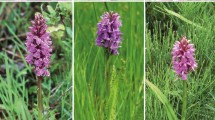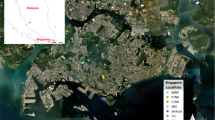Abstract
We examined the early life stage process of the kelp Ecklonia cava from zoospore settlement to juvenile sporophyte in the field. The microspatial genetic structure of an E. cava population in a 4 m × 4 m area was analyzed using microsatellite markers to evaluate the spatial distribution of individuals. Within this area, 169 adults and 87 juveniles were analyzed, and the distributional pattern was aggregated for juveniles, uniform for adults, and random for all individuals. The kinship coefficient decreased with increasing distance and reached zero at approximately 2 m. Using a parentage analysis, the parents of 8 and 46 juveniles in the study area were identified at the 95% and 80% confidence levels, respectively. Among the juveniles, selfing was confirmed in 3 and 7 individuals at the 95% and 80% confidence levels, respectively. Although the selfing juveniles that survived appeared to grow normally, the frequent occurrence of selfing may drive the distributional change between juveniles and adults. Most of the parents had two or fewer juvenile offspring within 2.5 m in the study area. Although the stipe length of the parents did not affect the dispersal distance of the zoospores, each parent appeared to release zoospores in a specific direction. In E. cava, the local population may be maintained by the short dispersal distance of most spores and the occurrence of selfing, and the rare zoospore settlement in distant areas may allow low levels of gene flow among local populations.











Similar content being viewed by others
References
Akita S, Koiwai K, Hanyuda T, Kato S, Nozaki R, Uchino T, Sakamoto T, Kondo H, Hirono I, Fujita D (2018) Development of 11 Ecklonia radicosa (Phaeophyceae, Laminariales) SSRs markers using next-generation sequencing and intra-genus amplification analysis. J Appl Phycol 30:2111–2115
Arakawa H, Matsuike K (1990) Influence on sedimentation velocity of brown algae zoospores and their base-plate insertion exerted by suspended matters. Nippon Suisan Gakkaishi 56:1741–1748 (in Japanese with English abstract)
Barner A, Pfister CA, Wootton JT (2011) The mixed mating system of the sea palm kelp Postelsia palmaeformis: few costs to selfing. Proc R Soc B 278:1347–1355
Carney LT (2011) A multispecies laboratory assessment of rapid sporophyte recruitment from delayed kelp gametophytes. J Phycol 47:244–251
Carney LT, Bohonak AJ, Edwards MS, Alberto F (2013) Genetic and experimental evidence for a mixed-age, mixed-origin bank of kelp microscopic stages in southern California. Ecology 94:1955–1965
Choi CG, Serisawa Y, Ohno M, Sohn CH (2000) Using the spore bag method. Algae 15:179–182
Choi DM, Ko YW, Kang R-S, Kim JH (2015) Morphological and genetic variability among Ecklonia cava (Laminariales, Phaeophyceae) populations in Korea. Algae 30:89–101
Coleman MA, Roughan M, Macdonald HS, Connell SD, Gillanders BM, Kelaher BP, Steinberg PD (2011) Variation in the strength of continental boundary currents determines continent-wide connectivity in kelp. J Ecol 99:1026–1032
Coleman MA, Feng M, Roughan M, Cetina-Heredia P, Connell SD (2013) Temperate shelf water dispersal by Australian boundary currents: implications for population connectivity. Limnol Oceanogr Fluids Environ 3:295–309
Coyer JA, Olsen JL, Stam WT (1997) Genetic variabilityand spatial separationin the sea palm kelp Postelsia palmaeformis (Phaeophyceae) as assessed with M13 fingerprints and RAPDs. J Phycol 33:561–568
Dayton PK (1973) Dispersion, dispersal, and persistence of the annual intertidal alga, Postelsia palmaeformis Ruprecht. Ecology 54:433–438
Dieck IT (1993) Temperature tolerance and survival in darkness of kelp gametophytes (Laminariales, Phaeophyta): ecological and biogeographical implications. Mar Ecol Prog Ser 100:253–264
Durrant HMS, Burridge CP, Kelaher BP, Barrett NS, Edgar GJ, Coleman MA (2013) Implications of macroalgal isolation by distance for networks of marine protected areas. Conserv Biol 28:438–445
Durrant HMS, Barrett NS, Edgar GJ, Coleman MA, Burridge CP (2018) Seascape habitat patchiness and hydrodynamics explain genetic structuring of kelp populations. Mar Ecol Prog Ser 587:81–92
Gaylord B, Reed DC, Raimondi PT, Washburn L (2006) Macroalgal spore dispersal in coastal environments: mechanistic insights revealed by theory and experiment. Ecol Monogr 76:481–502
Graham MH (2003) Coupling propagule output to supply at the edge and interior of a giant kelp forests. Ecology 84:1250–1264
Graham MH (2004) Effects of local deforestation on the diversity and structure of southern California giant kelp forest food webs. Ecosystems 7:341–357
Haraguchi H, Tanaka K, Imoto Z, Hiraoka M (2009) The decline of Ecklonia cava in Kochi, Japan and the challenge in marine afforestation. Kuroshio Sci 3:49–54
Hardy OJ, Vekemans X (2002) SPAGeDi: a versatile computer program to analyse spatial genetic structure at the individual or population levels. Mol Ecol Resour 2:618–620
Haroun R, Yokohama Y, Aruga Y (1989) Annual growth cycle of the brown alga Ecklonia cava in central Japan. Sci Mar 53:349–356
Hayashida F (1984) Potential production of the aquatic forest-forming brown alga, Ecklonia cava Kjellman, calculated from individual year classes. Hydrobiologia 116/117:429–432
Itou T, Kanno M, Suyama Y, Kamiyama A, Sakamoto SX, Kijima A, Inaba K, Aoki MN (2012) Development of 12 polymorphic microsatellite DNA markers for the kelp Ecklonia cava (Phaeophyceae, Laminariales). Mol Ecol Resour 4:459–461
Jarne P, Charlesworth D (1993) The evolution of the selfing rate in functionally hermaphrodite plants and animals. Ann Rev Ecol Syst 24:441–466
Johansson ML, Raimondi PT, Reed DC, Coelho NC, Serrão EA, Alberto FA (2013) Looking into the black box: simulating the role of self-fertilization and mortality in the genetic structure of Macrocystis pyrifera. Mol Ecol 22:4842–4854
Kalinowski ST, Taper ML, Marshall TC (2007) Revising how the computer program CERVUS accommodates genotyping error increases success in paternity assignment. Mol Ecol 16:1099–1106
Kang R-S, Won K-S, Hong K-P, Kim J-M (2001) Population studies on the kelp Ecklonia cava and Eisenia bicyclis in Dokdo, Korea. Algae 16:209–215
Kinoshita J (2009) Investigation of transplanting brown macroalgae (Ecklonia cava) on a submerged breakwater and growth of beds. J Fish Eng 45:169–178 (in Japanese with English abstract)
Kumagai NH, Molinos JG, Yamano H, Takao S., Fujii M, Yamanaka Y (2018) Ocean currents and herbivory drive macroalgae-to-coral community shift under climate warming. PNAS https://www.pnas.org/content/115/36/8990
Kusumo HT, Druehl LD (2000) Variability over space and time in the genetic structure of the winged kelp Alaria marginata. Mar Biol 136:397–409
Kusumo HT, Pfister CA, Wootton JT (2006) Small-scale genetic structure in the sea palm Postelsia palmaeformis Ruprecht (Phaeophyceae). Mar Biol 149:731–742
Loiselle BA, Sork VL, Nason J, Graham C (1995) Spatial genetic structure of a tropical understory shrub, Psychotria officinalis (Rubiaceae). Am J Bot 82:1420–1425
Maegawa M, Kida W (1989) Regeneration process of Ecklonia marine forest in the coastal area of Shima Peninsula, central Japan. Jpn J Phycol 37:194–200
Maegawa M, Kida W, Aruga Y (1988) A demographic study of the sublittoral brown alga Ecklonia cava Kjellman in coastal water of Shima Peninsula, Japan. Jpn J Phycol 36:321–327
Marshall CT, Slate J, Kruuk BEL, Pemberton MJ (1998) Statistical confidence for likelihood-based paternity inference in natural populations. Mol Ecol 7:639–655
Migita S (1984) Intergeneric and interspecific hybridization between four species of Eisenia and Ecklonia. Rep Fish Fac Nagasaki Univ 56:15–20 (in Japanese with English abstract)
Peakall R, Smouse PE (2012) GenAlEx 6.5: genetic analysis in Excel. Population genetic software for teaching and research-an update. Bioinformatics 28:2537–2539
Pemberton JM, Slate J, Bancroft DR, Barrett JA (1995) Nonamplifying alleles at microsatellite loci: a caution for parentage and population studies. Mol Ecol 4:249–252
Raimondi PT, Reed DC, Gaylord B, Washburn L (2004) Effects of self-fertilization in the giant kelp, Macrocystis pyrifera. Ecology 85:3267–3276
Reed DC, Laur DR, Ebeling AW (1988) Variation in algal dispersal and recruitment: the importance of episodic events. Ecol Monogr 58:321–335
Sagawa T, Mikami A, Aoki MN, Komatsu T (2012) Mapping seaweed forests with IKONOS image based on bottom surface reflectance. In: Frouin RJ, Ebuchi N, Pan D, Saino T (eds) Remote Sensing of the Marine Environment II. Proc. SPIE 8525:85250Q
Santelices B (1990) Patterns of organizations of intertidal and shallow subtidal vegetation in wave exposed habitats of central Chile. Hydrobiologia 192:35–57
Schiel DR, Foster MS (2006) The population biology of large brown seaweeds: ecological consequences of multiphase life histories in dynamic coastal environments. Ann Rev Ecol Evol Syst 37:343–372
Schiel DR, Foster MS (2015) The biology and ecology of giant kelp forest. Univ California Press, Oakland
Serisawa Y, Akino H, Matsuyama K, Ohno M, Tanaka J, Yokohama Y (2002) Morphometric study of Ecklonia cava (Laminariales, Phaeophyta) sporophytes in two localities with different temperature conditions. Phycol Res 50:201–207
Serisawa Y, Imoto Z, Ishikawa T, Ohno M (2004) Decline of the Ecklonia cava population associated with increased seawater temperatures in Tosa Bay, southern Japan. Fish Sci 70:189–191
Serisawa Y, Imoto Z, Taino S, Choi CG, Ishikawa T, Ohno M, Hiraoka M (2005) Marine afforestation of Ecklonia cava by using a spore bag method at an ISOYAKE area in Tosa Bay, southern Japan. Jpn J Phycol 53:19–24 (in Japanese with English abstract)
Southwood TRE, Henderson PA (2000) Ecological methods, 3rd edn. Blackwell Science, Oxford
Sudo S (1948) Shedding, swimming and fixing of the zoospores in some species of Laminariaceae. Nippon Suisan Gakkaishi 13:123–128 (in Japanese with English abstract)
Takao S, Kumagai NH, Yamano H, Fujii M, Yamanaka Y (2015) Projecting the impacts of rising seawater temperatures on the distribution of seaweeds around Japan under multiple climate change scenarios. Ecol Evol 5:213–223
Tanaka K, Taino S, Haraguchi H, Prendergast G, Hiraoka M (2012) Warming off southwestern Japan linked to distributional shifts of subtidal canopy-forming seaweeds. Ecol Evol 2:2854–2865
Wernberg T, Coleman MA, Bennett S, Thomsen MS, Tuya F, Kelaher P (2018) Genetic diversity and kelp forest vulnerability to climatic stress. Sci Rep 8:1851
Yokohama Y, Tanaka J, Chihara M (1987) Productivity of the Ecklonia cava community in a bay of Izu Peninsula on a Pacific coast of Japan. Bot Mag Tokyo 100:129–141
Acknowledgments
We sincerely thank Y. Tsuchiya and T. Sato, the previous technical staff members of the Shimoda Marine Research Center, for their assistance in the field survey.
Funding
The Mikimoto Fund for Marine Ecology supported this study in the fiscal year 2010.
Author information
Authors and Affiliations
Corresponding author
Additional information
Publisher’s note
Springer Nature remains neutral with regard to jurisdictional claims in published maps and institutional affiliations.
Rights and permissions
About this article
Cite this article
Itou, T., Kanno, M., Suyama, Y. et al. Opening the black box: microspatial patterns of zoospore dispersal, parentage, and selfing in the kelp Ecklonia cava as revealed by microsatellite markers. J Appl Phycol 31, 3283–3294 (2019). https://doi.org/10.1007/s10811-019-01790-0
Received:
Revised:
Accepted:
Published:
Issue Date:
DOI: https://doi.org/10.1007/s10811-019-01790-0




